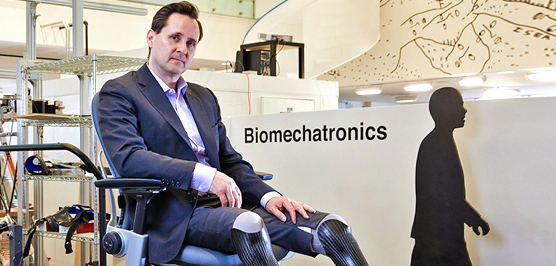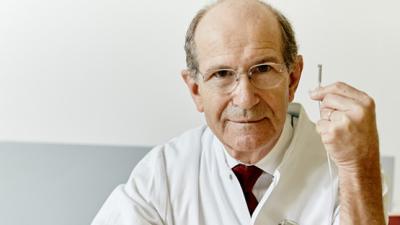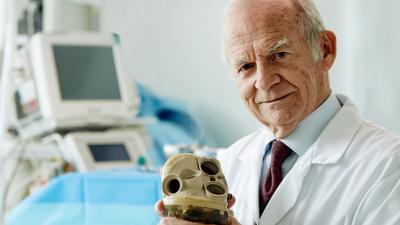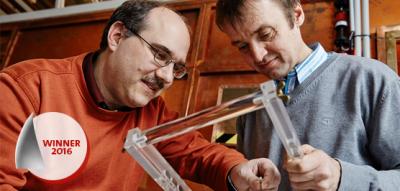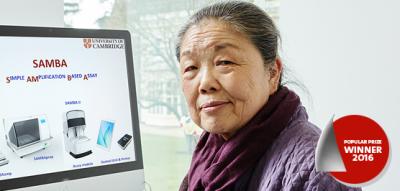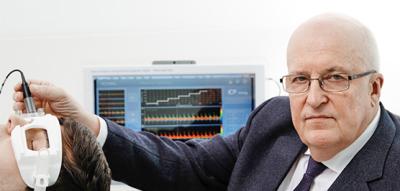Hugh Herr
Biomechatronic leg joints
Finalist for the European Inventor Award 2016
Hugh Herr's "bionic knee", introduced in 2007, enables amputees to walk with a fluid, natural gait thanks to a combination of microprocessors and adaptive impact dampening based on posture and weight distribution. Heralded as a milestone improvement over static, non-adaptive prosthetics such as the rubber Jaipur Foot invented in 1971, the "smart" prosthesis has changed the lives of thousands of amputees worldwide.
Herr and his team at MIT's Biomechatronics Group achieved their breakthrough by mimicking the knee's adaptive response to pressure and weight through a magnetic dampening liquid, activated by feedback from sensors placed inside the prosthesis. The prolific inventor also created the BiOM T2, the world's first battery-powered prosthetic foot and ankle to mimic the function of the foot with a complex network of microprocessors, released in 2010.
Societal benefit
Each year, approximately three to four million people worldwide undergo seriously debilitating amputations, suffering harsh limitations on mobility and lifestyle as a consequence. In the US alone, approximately 185 000 amputations are performed each year. The incidence of amputation is around 1.5 per 1 000 among the civilian population, plus a high number among members of the armed forces.
Herr's devices have already changed the lives of hundreds of amputees. As of April 2014, more than 1 000 BiOM T2 system ankle prostheses have been fitted to patients, nearly half of whom are US veterans. The ankle prosthesis currently comes with a price tag of around EUR 35 000 (USD 40 000) per unit, but the social benefits in terms of autonomous lifestyles and workforce participation are invaluable.
Economic benefit
In 2007, Herr co-founded spin-off company iWalk, initially investing EUR 20 million (USD 25 million) in perfecting bionic prostheses. Now operating under the name BionX Medical Technologies, the privately held company with 45 employees generated over EUR 30.8 million (USD 35 million) in revenue between 2011 and 2014. Herr's knee prosthesis has been licensed to Icelandic company Ossur, which is currently the world's number two prosthetics manufacturer. The prosthetic knee, marketed as the Rheo Knee, is now in its third generation with a new weather-proof design. In 2015, Ossur reported EUR 434 million (USD 483 million) in turnover, with sales of bionic products at 16% of prosthetic component sales.
Herr's "bionic" prostheses are part of a vital growth segment: the global microprocessor-controlled (MPC) prosthetics market reached EUR 393.4 million (USD 434.4 million) in 2015 (SA-Business Research & Consulting). In the bigger picture, Global Industry Analysts expects the value of the global prosthetics market to reach EUR 19.2 billion by 2017.
How it works
Herr's inventions take rehabilitation technology into the realm of bionics - the intersection between medicine and information technology. The computer-equipped Rheo Knee calculates the wearer's posture and position in the environment based on feedback from sensors. The artificial joint then adjusts its level of resistance - mimicking the natural motion of a knee - through a "magnetorheological" fluid, a dampening liquid controlled by an electromagnet.
Inside the BiOM T2 system ankle prostheses, a series of built-in microprocessors and environmental sensors constantly evaluates data on weight distribution and surface incline, while battery-powered springs propel the wearer forward in a fluid, calculated manner.
The inventor
As a teenager, Herr was a highly competitive mountain climber until he tragically lost both legs beneath the knees during a mountain expedition at the age of 17. Since then, he has pursued his lifelong dream of climbing mountains at an elite level - made possible by his pioneering, intelligent prostheses.
During his highly prolific career in the field of biomedical devices spanning over 30 years, Herr has published more than 60 research papers and 30 patents for prostheses and assistive devices. Since 2000, he has been heading the 35-person Biomechatronics Group at MIT's Media Lab in Boston. In 2007, he founded a spin-off company out of MIT under the name iWalk (now BionX Medical Technologies, Inc.) to bring his inventions to market.
Considered one of the top biomechatronics researchers in the world, Herr has received major accolades including the Popular Mechanics Breakthrough Leadership Award (2005), the Heinz Award for Technology, the Economy and Employment (2007) and R&D Magazine's 14th Innovator of the Year Award (2014). His innovations were listed twice among TIME magazine's Top Ten Inventions (2004; 2007).
Did you know?
"Bionic" prostheses allow amputees to perform at the same level as able-bodied athletes - and perhaps even better. In 2008, the governing body of international athletics, IAAF, banned competitors wearing the carbon-fibre "Cheetah" prostheses from entering the Olympics, citing "unfair advantage" as the reason.
The athletic team of Icelandic prosthetics company Ossur - licensees of Herr's invention - dominated at the 2015 Athletics World Championships held by the International Paralympic Committee (IPC) in Qatar, winning 17 medals (seven gold, six silver, and four bronze). The team also set six new world records, including US sprinter Richard Browne Jr.'s 10.61 second finish in the 100 metres sprint event.
Media gallery
Contact
European Inventor Award and Young Inventors Prize queries:
european-inventor@epo.org Subscribe to the European Inventor Award newsletterMedia-related queries:
Contact our Press team#InventorAward #YoungInventors
